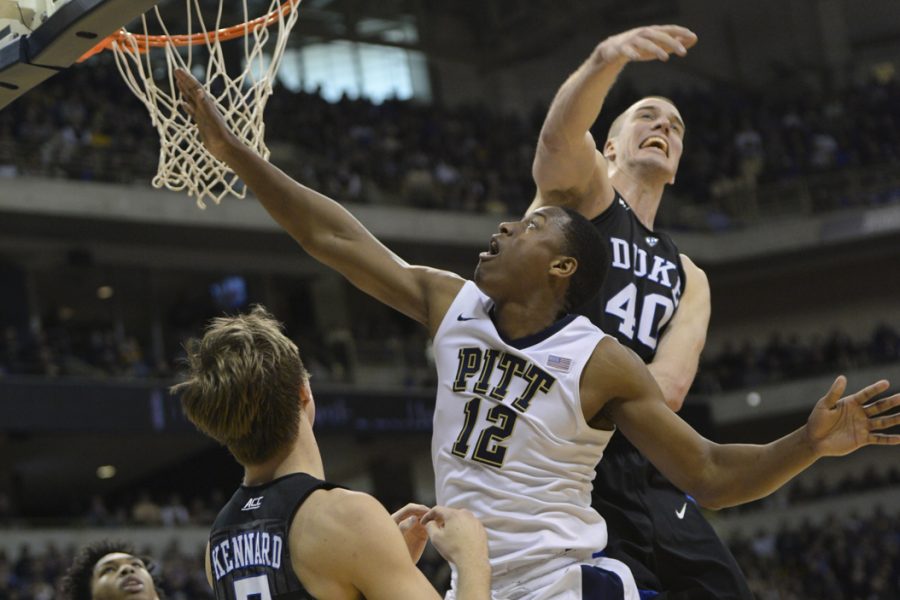At 6-foot-6, Pitt senior guard Chris Jones has dunked over taller defenders. He’s scored 20 points in games against the best college basketball teams in the country. And he’s locked down the stars, like Duke’s Grayson Allen.
But this summer at a Pitt basketball practice, Jones achieved something that has eluded him since he was a boy growing up in Teaneck, New Jersey.
The guard was stretching in a workout session when he ran up to new strength and conditioning coach Garry Christopher “like a little kid” with rampant and surprised excitement.
“Coach,” Jones said. “I touched my toes! I’ve never been able to touch my toes!”
Jones’ newfound flexibility is an added component of a stringent offseason workout and nutrition plan Christopher implemented, one that has helped the senior shed five pounds and trade in some remnant fat for muscle. Now leaner, Jones is prepared to make more of an impact this season than he was able to in the past.
Jones knew conditioning was going to be a focal point of his offseason work, and his new head coach, Kevin Stallings, hammered that point home during summer workouts with a biting nickname.
“I think Chris got the message when I started calling him the Pillsbury Doughboy,” Stallings said. “I said so lovingly.”
Stallings said he would go up to Jones and poke him in the stomach “to see if he’d laugh like the old commercial.”
Jones knew Stallings wasn’t being mean-spirited but still understood there was a message behind the lighthearted barb.
“He was kind of saying it as a joke,” Jones said. “But, you know, all jokes hold some kind of truth. I kind of took it as a hint and said, ‘Let me start working on my body.’”
That process started with a meeting with Christopher, who spent the past three seasons in the same position at Vanderbilt with Stallings.
Christopher held preliminary screenings with everyone on the roster. The offseason is a perfect time to tackle these individual requirements, he said.
“We have team goals, of course, but when it comes to [the offseason], we cater their training based off each person: where they are, imbalances, inefficiencies,” Christopher said. “Whatever they are, we target them very aggressively.”
Christopher’s initial assessment included a variety of tests. He conducted postural and spinal assessments as well as a functional movement screening, which grades ability of normal movement patterns.
He even brought all of his players to Pitt’s Neuromuscular Research Lab on campus, where the Panthers underwent more tests to measure lower body flexibility, lower body strength, power, velocity and vertical jumping.
When Christopher met with Jones, he found a player with inherent athleticism but traits that held him back. His hips, hamstrings and quads were tight, limiting flexibility, and some body fat made Jones “a little overweight” coming into the summer. He came into workouts at 228 pounds.
“You could see it on the court: moving around, he was just sluggish,” Christopher said. “He wasn’t conditioned very well.”
Jones agreed with that assessment.
“[My plan] has been about building muscle and cutting body fat,” Jones said. “I was a little chubby before. That’s why Coach Stallings came up to me [and called me Doughboy].”
In terms of remedying these issues, Christopher said Pitt’s training program for Jones was “nothing cutting edge.”
Prior to practices, Jones would undergo “metabolic conditioning,” which consisted of circuit training and cardio equipment in order to help shed some of the weight prior to the more strength-intensive workout sessions.
Along with the training, nutrition was just as key for Jones. Christopher and his staff tailored a diet plan for each player with easy-to-cook meals and go-to eateries around campus. Jones’ packet listed healthy options like pasta dishes and burritos.
“Surprisingly, [the nutrition guide] wasn’t just like, ‘Here, eat salad every day,’” Jones said. “It’s good meals, good stuff.”
The work began to manifest itself in practice simply beyond Jones’ reaching down and grazing his shoes. Sheldon Jeter highlighted a moment in workouts where his teammate’s conditioning really showed, leaping higher than anyone on the team had ever seen him.
“He made a really athletic play that I’ve never seen him make,” Jeter said. “Coach was like, ‘Good job, Pillsbury!’ You kind of had to take notice, like, ‘Wow, his body is changing physically.’”
Beyond the vertical improvements, Jones noticed development on the cardiovascular spectrum, highlighting improved performance in drills.
“When we started getting up and down [the court], I really felt lighter. I felt faster, and I wasn’t as tired,” Jones said. “So I was like, ‘Maybe something’s working here.’”
Jones looks noticeably different than he did at the end of last season — Stallings now refers to him as “sculpted.”
Christopher says this is the most foolproof sign of improvement in players.
“That’s when you know a kid is making progess,” Christopher said. “When they can see it themselves and everyone else is kind of noticing.”
While the improvement in the offseason has yet to manifest itself on the court, Jones, a projected starter for the Panthers, is confident that it will.
“It’s definitely going to let my time on the court be more impactful,” Jones said. “Defensively, it’s going to help me a great deal, being able to stick.”
Jones says he’s currently in the best shape of his life and is thrilled to be so in his final run as a college basketball player.
“This is it,” Jones said. “You want to leave your mark, your impact. So I’m excited that it’s coming now.”


